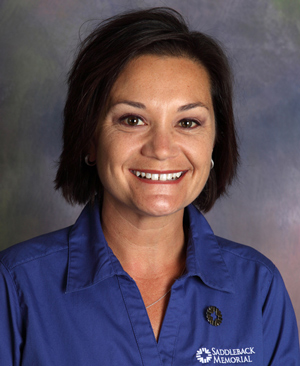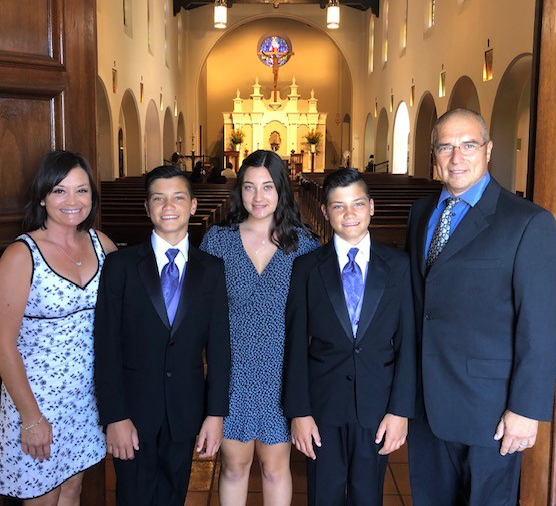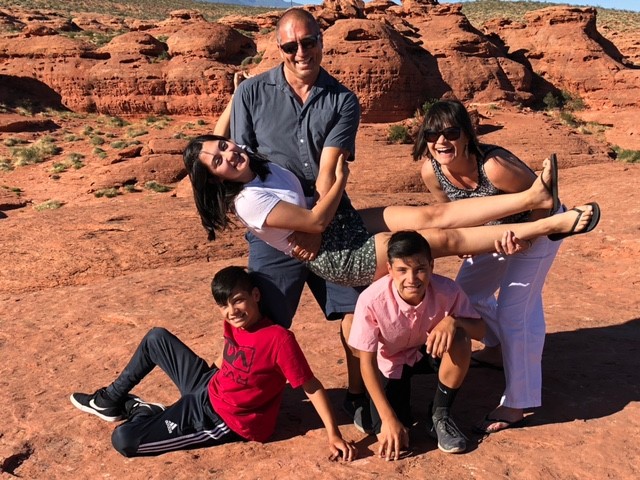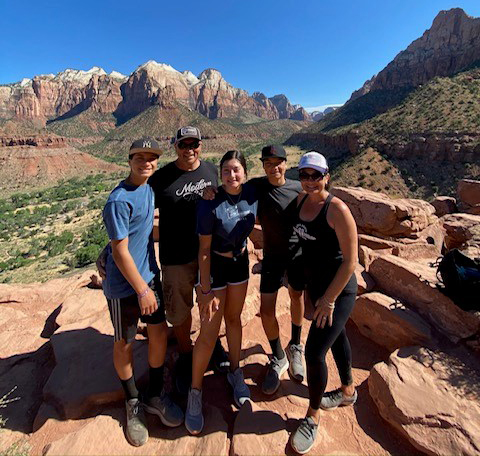 I am the ICU Educator at Saddleback, and patient stories and what their families go through in intensive care are at the heart of what we do. My favorite things are the photos and posters that our staff help the families put up in the ICU room, pictures of our patients when they are active and loving life with their friends and families.
I am the ICU Educator at Saddleback, and patient stories and what their families go through in intensive care are at the heart of what we do. My favorite things are the photos and posters that our staff help the families put up in the ICU room, pictures of our patients when they are active and loving life with their friends and families.
They are a powerful inspiration as we try to save our patients and restore them to their lives.
My mother was an ICU nurse. Right out of nursing school she was in the Army Nurse Corps and was soon on a plane to Vietnam. She marvels today at the level of care we provide in critical care. I met my husband Fred in my nursing class at San Diego State. He is an ER nurse, and we have three beautiful souls God gave us to look after. I trusted my Saddleback family with my life back then.
Little did I know I would be trusting them with my life again 14 years later.
It was April 7, 2020. We were months into COVID-19 ICU surge planning. That day, I had actually danced for a few minutes with co-workers to let off steam. It was our nursing director’s birthday.
A huge priority and effort was on PPE-personal protective equipment for our staff. As we danced, I changed the lyrics in “OPP, ya you know me” to “PPE” –"You down with PPE, Ya you know me!” It was a few wonderful minutes with my team that relieved stress and made us smile.
At 4:15 at my desk, I started to feel restless and weird. I stood up to try and shake it off, but I felt a sense of impending doom.
I knew I should not be alone. I went straight into our unit seeking our charge nurse that day, Kerissa.
Maybe it’s a panic attack, I thought. Then a pressure like a cookie-cutter size circle in the center of my sternum started pressing and pressing.
Kerissa and other nurses convinced me to lie down and get on a monitor. They told me they saw irregular ventricular beats coming in twos. This is called bigeminy. Then adding to the pressure in my chest came a tingling down both my arms.
I was still resisting my colleagues who said they needed to get me down to the ER, but they are critical care nurses, so they took charge. Before I knew it, I was in a wheelchair and on the way to the Emergency Dept. IVs were put in, labs drawn, EKG, etc.
Twenty minutes later, they tell me the EKG is not normal, and a segment on the EKG that shows decreased blood flow in a part of the heart. I hear the words “acute anterolateral infarct, LAD.”
They tell me, “Gina, we have to get you in the cath lab (cardiac catheterization).” They call my husband while I am asking who is on-call for interventional cardiology.
I hear on the page overhead: “Code STEMI,” the call for a heart attack. I was in the cath lab 36 minutes from the moment I was sitting at my desk starting to feel weird.
My mind was spinning. This can’t be happening.
They tell me, “Gina, let go, and be the patient not the nurse, stop trying to figure this out…”
When I reflect on those moments, it felt like I had the whole cath lab staff of nurses and techs, all reassuring me, caring for me, efficiently rushing in an orchestrated way.
Then, the chest pain lessened and left. I heard, “Gina you did great, that was tricky, your artery was dissecting but we got a good outcome, there is a stent in your LAD, it was completely blocked.”
I couldn’t have imagined it in my wildest dreams.
Inside my heart, the main vessel that feeds the heart muscle called the LAD (left anterior descending) artery had started to tear. This is known as SCAD, which stands for Spontaneous Coronary Artery Dissection. It strikes without warning, usually women in their 40s or 50s. The first scientific statement was published just in May 2018.
 This uncommon emergency condition occurs when a tear forms in a blood vessel in the heart. It can slow or block blood flow to the heart, causing a heart attack, abnormalities in heart rhythm - or sudden death. People who have SCAD often don't have risk factors for heart disease, such as high blood pressure, high cholesterol or diabetes.
This uncommon emergency condition occurs when a tear forms in a blood vessel in the heart. It can slow or block blood flow to the heart, causing a heart attack, abnormalities in heart rhythm - or sudden death. People who have SCAD often don't have risk factors for heart disease, such as high blood pressure, high cholesterol or diabetes.
We don’t know when our time on this earth will be up, do we? I came pretty close that day, but it wasn’t time yet in God’s plan. My SCAD happened in my work home, in our unit, with angel nurses surrounding me and our amazing Saddleback team saving me in our own cath lab.
To me it is also a miracle that Dr. Kuo was the on-call cardiologist. As I mentioned, how to treat SCAD it is still being discussed and studied, but Dr. Kuo knew SCAD and knew just what to do.
Arriving at the ICU after being in the cath lab was a blur. Dr. Kuo and Dr. Vo, our intensivist, told me, “SCAD is so rare; it causes less than 2% of heart attacks. You are so lucky. There was no plaque, you have low blood pressure, low cholesterol, no history, no risk factors for heart disease.”
Yet my artery was completely blocked because of SCAD.
That evening, the pressure in the center of my chest came back. There were more nurses back in the room, paging doctors, morphine helps, 12 lead EKG. Not again, I thought.
 But I felt my nurse’s reassuring hands starting a nitro drip. I heard her calming voice, and then the pain is worse. Then I felt Judy’s arms over the tubing on my arms and wires around my chest, through the pain and fear, I felt the tug of the defibrillator pads clinging to my chest … I felt these nurses relieving my suffering.
But I felt my nurse’s reassuring hands starting a nitro drip. I heard her calming voice, and then the pain is worse. Then I felt Judy’s arms over the tubing on my arms and wires around my chest, through the pain and fear, I felt the tug of the defibrillator pads clinging to my chest … I felt these nurses relieving my suffering.
I felt so sorry for my nurses, my friends, the stress they shouldered of this whole COVID crisis and now your educator is your patient. They told me to stop apologizing, to breathe. And, finally the pain subsided.
I stayed for two more nights and thankfully the chest pain never returned. Every face I saw and hand I felt was precious to me. There was nothing but kindness, caring, and competence from those who cared for me.
I think back to April 7. I had almost left the hospital to drive home 15 minutes before that first feeling that something was not quite right. I could have been driving, I could have been home and stayed in denial too long. The “could haves” go on.
Looking back, whatever ripped my heart apart, faith and Saddleback put it back together in the Cath Lab, in ICU.
 I returned to work in the ICU last summer. The cardiac rehab team helped me heal and overcome my fears of doing physical exercise again. Currently, doctors think there is a 1 in 5 chance of reoccurrence.
I returned to work in the ICU last summer. The cardiac rehab team helped me heal and overcome my fears of doing physical exercise again. Currently, doctors think there is a 1 in 5 chance of reoccurrence.
But I am not a number. We are not numbers at Saddleback. We are mothers, daughters, wives, friends, and children of God with a story.
But there is always good even in the pain and this is part of my faith over fear, not letting the fear become what we allow to drive us. There is always good.
One of my family’s favorite sayings right now is, “I’m happy. I’m happy not because everything is good. I’m happy because I can see the good in everything.”